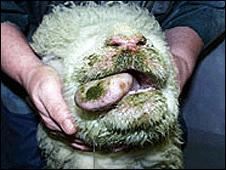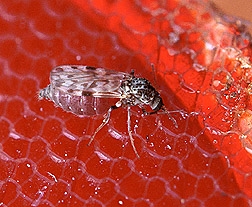
Bluetongue is an endemic disease in California and is a common problem of unvaccinated sheep living in the San Joaquin Valley of California. The disease is seasonal and is usually seen in the late summer and early fall months. Most clinical cases are usually seen during the months of August through the end of October. Bluetongue disease occurs worldwide and has recently caused serious economic problems in livestock in northern Europe.
Bluetongue is caused by a virus that is a member of the Orbivirus genus. This disease is not contagious from animal to animal and must be spread to

Although Bluetongue virus infects many different domestic (cattle, sheep and goats) and wild ruminant (deer) species, sheep tend to be the species most seriously affected. One particularly serious bluetongue strain of virus (Bluetongue virus strain 8) that was recently introduced into Northern Europe from Africa is currently causing significant disease in sheep, cattle and goats. The strains of bluetongue virus in California tend to produce no disease symptoms in cattle and goats while causing apparent and severe disease in sheep.
Symptoms in infected sheep include elevated body temperatures (105oF to 107oF), excessive salivation, swelling of the face, lips, and nose, ulcers and erosions of the dental pad, tongue and lips, swelling and discoloration of the tongue (blue tongue), difficulty in standing and/or lameness with swelling and/or ulceration of the coronary bands and hemorrhaging of the mucus membranes of the mouth and tongue. Some sheep may have respiratory difficulty due to pulmonary edema in the lungs. Other sheep with significant lesions in the mouth, tongue and esophagus may occasionally vomit with aspiration to the lungs which can lead to severe pneumonia. Mortality can be variable with death rates approaching 30% to 80% of the infected animals. Infected pregnant animals that survive clinical disease can have abortions or deliver young that are deformed, blind, weak, or have serious neurological defects.
Yearly vaccination of animals in the spring protects most sheep from becoming seriously affected by this viral agent. Since the Bluetongue vaccine is a modified live vaccination it is not recommended to vaccinate pregnant sheep because the virus in the vaccine may cause abortions or deformities in the fetus.
If you suspect bluetongue in your sheep you should contact your veterinarian immediately and discuss further testing of your flock. Testing of sick or dead animals for this disease can be accomplished through your regional veterinary diagnostic laboratory.
Author - County Director Mendocino & Lake/Livestock & Natural Resources Advisor - Emeritus